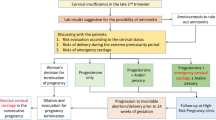Abstract
Objectives
Cervical incompetence complicates approximately 1 in 500 pregnancies and is the most common cause of second-trimester spontaneous abortion and preterm labor. No prospective or large retrospective studies have compared regional and general anesthesia for cervical cerclage.
Study design
Following IRB approval, we performed a retrospective study in the two main medical centers over an 8-year period to assess the association of anesthesia choice with anesthetic and obstetric outcomes. Anesthetic and perioperative details were retrospectively collected from fails of all patients undergoing cervical cerclage from 01/01/2005 until 31/12/2012. Details included demographic data, anesthetic technique, PACU data and perioperative complications.
Results
We identified 487 cases of cervical cerclage in 327 women during the study period. The most commonly used anesthetic technique was general anesthesia (GA) (402/487; 82.5 %) compared with regional anesthesia (RA) (85/487; 17.5 %). When GA was performed, facemask was the most commonly used technique (275/402; 68.4 %), followed by intravenous deep sedation (61/402; 15.2 %); LMA (51/402; 12.7 %) and tracheal intubation (13/402; 3.2 %). There were no significant differences in demographic characteristics between women receiving general and regional anesthesia. Average duration of suturing the cervix among the GA group was 9.8 ± 1.6 and 10.6 ± 2.1 min in the RA group (p < 0.001). Average length of stay in the operating room in the GA group was 20.5 ± 3.9 and 23 ± 4.6 min in the RA group (p < 0.001). Patients receiving GA received in the PACU more opioids (6.2 versus 1.2 %; p < 0.05) and more non-opioids analgesics (36.8 versus 9.4 %; p < 0.001). Duration of PACU stay was shorter after GA (49.5 ± 18 min) than after RA (62.4 ± 28 min; p < 0.001). There were no other differences in anesthetic or perioperative outcome between groups. This study was not designed to provide evidence that RA reduces the risk of pulmonary aspiration, airway complications or adverse fetal neurological effects from maternal anesthetic exposure.
Conclusions
Both regional and general anesthesia were safely used for the performance of cerclage. Patients after general anesthesia had a shorter recovery time but a higher demand for opioids and non-opioids analgesia.
Similar content being viewed by others
References
Fox NS, Chervenak FA (2008) Cervical cerclage: a review of the evidence. Obstet Gynecol Surv 63:58–65
Debbs RH, Chen J (2009) Contemporary use of cerclage in pregnancy. Clin Obstet Gynecol 52:597–610
Anum EA, Brown HL, Strauss JF 3rd (2010) Health disparities in risk for cervical insufficiency. Hum Reprod 25:2894–2900
Owen J, Mancuso M (2012) Cervical cerclage for the prevention of preterm birth. Obstet Gynecol Clin North Am 39:25–33
Yoon HJ, Hong JY, Kim SM (2008) The effect of anesthetic method for prophylactic cervical cerclage on plasma oxytocin: a randomized trial. Int J Obstet Anesth 17:26–30
Lee GY, Kim CH, Chung rk et al (2009) Spread of subarachnoid sensory block with hyperbaric bupivacaine in second trimester of pregnancy. J Clin Anesth 21:482–485
Schumann R, Rafique MB (2003) Low-dose epidural anesthesia for cervical cerclage. Can J Anaesth 50:424–425
Carlin A, Alfirevic Z (2008) Physiological changes of pregnancy and monitoring. Best Pract Res Clin Obstet Gynaecol 22:801–823
Loebstein R, Lalkin A, Koren G (1997) Pharmacokinetic changes during pregnancy and their clinical relevance. Clin Pharmacokinet 33:328–343
Kuczkowski KM (2004) Nonobstetric surgery during pregnancy: what are the risks of anesthesia? Obstet Gynecol Surv 59:52–56
Rosen MA (1999) Management of anesthesia for the pregnant surgical patient. Anesthesiology 91:1159–1163
Palahniuk RJ, Shnider SM, Eger EI 2nd (1974) Pregnancy decreases the requirement for inhaled anesthetic agents. Anesthesiology 41:82–83
Hess W (1987) Pregnancy and oxygen dissociation. Anesthesiology 66:854–855
Van De Velde M, De Buck F (2007) Anesthesia for non-obstetric surgery in the pregnant patient. Minerva Anestesiol 73:235–240
Reitman E, Flood P (2011) Anaesthetic considerations for non-obstetric surgery during pregnancy. Br J Anaesth 107(Suppl 1):72–78
Barash PG, Cullen BF, Stoelting RK, Cahalan M, Stock MC (eds) (2009) Clinical anesthesia, 6th edn. Lippincott Williams & Wilkins, Philadelphia
Chestnut D (eds) (2004) Obstetric anesthesia: principles and practice, 3rd edn
Beck-Schimmer B, Bonvini JM (2011) Bronchoaspiration: incidence, consequences and management. Eur J Anaesthesiol 28:78–84
Paranjothy S, Griffiths JD, Broughton HK, Gyte GM, Brown HC, Thomas J (2014) Interventions at caesarean section for reducing the risk of aspiration pneumonitis. Cochrane Database Syst Rev 2:CD004943
Palanisamy A (2012) Maternal anesthesia and fetal neurodevelopment. Int J Obstet Anesth 21:152–162
Sanders RD, Hassell J, Davidson AJ, Robertson NJ, Ma D (2013) Impact of anaesthetics and surgery on neurodevelopment: an update. Br J Anaesth 110(Suppl 1):i53–i72
Conflict of interest
None.
Author information
Authors and Affiliations
Corresponding author
Additional information
A. Ioscovich and A. Popov contributed equally to this work and are co-first authors.
Rights and permissions
About this article
Cite this article
Ioscovich, A., Popov, A., Gimelfarb, Y. et al. Anesthetic management of prophylactic cervical cerclage: a retrospective multicenter cohort study. Arch Gynecol Obstet 291, 509–512 (2015). https://doi.org/10.1007/s00404-014-3391-5
Received:
Accepted:
Published:
Issue Date:
DOI: https://doi.org/10.1007/s00404-014-3391-5




